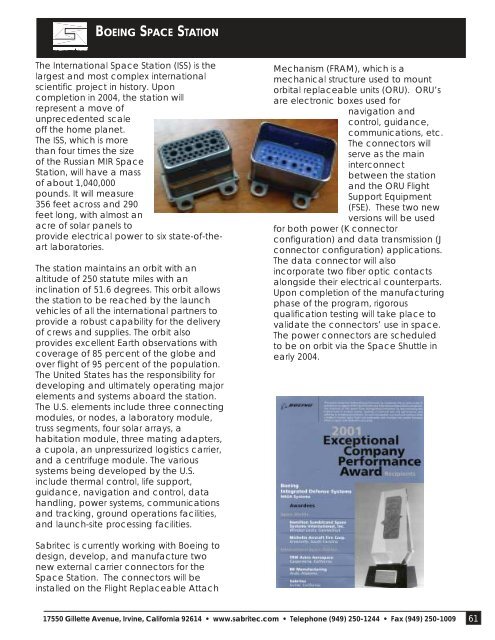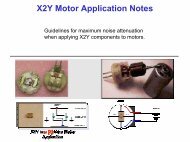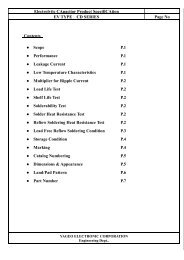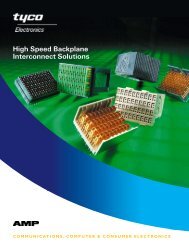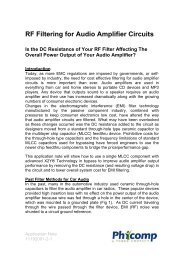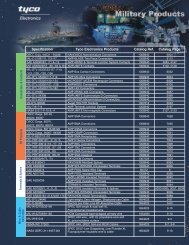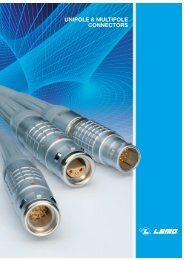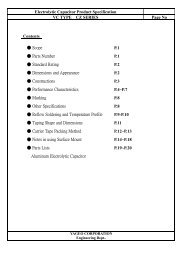Space Connectors.pmd
Space Connectors.pmd
Space Connectors.pmd
Create successful ePaper yourself
Turn your PDF publications into a flip-book with our unique Google optimized e-Paper software.
BOEING SPACE STATION<br />
The International <strong>Space</strong> Station (ISS) is the<br />
largest and most complex international<br />
scientific project in history. Upon<br />
completion in 2004, the station will<br />
represent a move of<br />
unprecedented scale<br />
off the home planet.<br />
The ISS, which is more<br />
than four times the size<br />
of the Russian MIR <strong>Space</strong><br />
Station, will have a mass<br />
of about 1,040,000<br />
pounds. It will measure<br />
356 feet across and 290<br />
feet long, with almost an<br />
acre of solar panels to<br />
provide electrical power to six state-of-theart<br />
laboratories.<br />
The station maintains an orbit with an<br />
altitude of 250 statute miles with an<br />
inclination of 51.6 degrees. This orbit allows<br />
the station to be reached by the launch<br />
vehicles of all the international partners to<br />
provide a robust capability for the delivery<br />
of crews and supplies. The orbit also<br />
provides excellent Earth observations with<br />
coverage of 85 percent of the globe and<br />
over flight of 95 percent of the population.<br />
The United States has the responsibility for<br />
developing and ultimately operating major<br />
elements and systems aboard the station.<br />
The U.S. elements include three connecting<br />
modules, or nodes, a laboratory module,<br />
truss segments, four solar arrays, a<br />
habitation module, three mating adapters,<br />
a cupola, an unpressurized logistics carrier,<br />
and a centrifuge module. The various<br />
systems being developed by the U.S.<br />
include thermal control, life support,<br />
guidance, navigation and control, data<br />
handling, power systems, communications<br />
and tracking, ground operations facilities,<br />
and launch-site processing facilities.<br />
Mechanism (FRAM), which is a<br />
mechanical structure used to mount<br />
orbital replaceable units (ORU). ORU’s<br />
are electronic boxes used for<br />
navigation and<br />
control, guidance,<br />
communications, etc.<br />
The connectors will<br />
serve as the main<br />
interconnect<br />
between the station<br />
and the ORU Flight<br />
Support Equipment<br />
(FSE). These two new<br />
versions will be used<br />
for both power (K connector<br />
configuration) and data transmission (J<br />
connector configuration) applications.<br />
The data connector will also<br />
incorporate two fiber optic contacts<br />
alongside their electrical counterparts.<br />
Upon completion of the manufacturing<br />
phase of the program, rigorous<br />
qualification testing will take place to<br />
validate the connectors’ use in space.<br />
The power connectors are scheduled<br />
to be on orbit via the <strong>Space</strong> Shuttle in<br />
early 2004.<br />
Sabritec is currently working with Boeing to<br />
design, develop, and manufacture two<br />
new external carrier connectors for the<br />
<strong>Space</strong> Station. The connectors will be<br />
installed on the Flight Replaceable Attach<br />
17550 Gillette Avenue, Irvine, California 92614 • www.sabritec.com • Telephone (949) 250-1244 • Fax (949) 250-1009<br />
61


